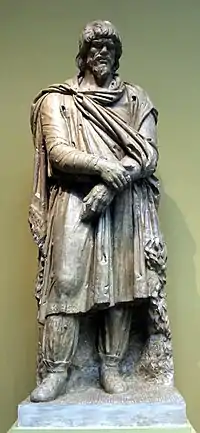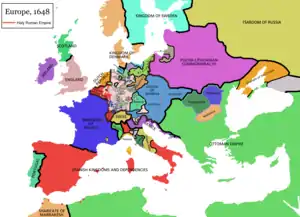Portal:Romania
This article is issued from Wikipedia. The text is licensed under Creative Commons - Attribution - Sharealike. Additional terms may apply for the media files.
Portal maintenance status: (July 2018)
|
The Romania Portal
Romania (/roʊˈmeɪniə/ ( Settlement in what is now Romania began in the Lower Paleolithic followed by written records attesting the kingdom of Dacia, its conquest, and subsequent Romanization by the Roman Empire during late antiquity. The modern Romanian state was formed in 1859 through a personal union of the Danubian Principalities of Moldavia and Wallachia. The new state, officially named Romania since 1866, gained independence from the Ottoman Empire in 1877. During World War I, after declaring its neutrality in 1914, Romania fought together with the Allied Powers from 1916. In the aftermath of the war, Bukovina, Bessarabia, Transylvania, and parts of Banat, Crișana, and Maramureș became part of the Kingdom of Romania. In June–August 1940, as a consequence of the Molotov–Ribbentrop Pact and Second Vienna Award, Romania was compelled to cede Bessarabia and Northern Bukovina to the Soviet Union and Northern Transylvania to Hungary. In November 1940, Romania signed the Tripartite Pact and, consequently, in June 1941 entered World War II on the Axis side, fighting against the Soviet Union until August 1944, when it joined the Allies and recovered Northern Transylvania. Following the war and occupation by the Red Army, Romania became a socialist republic and a member of the Warsaw Pact. After the 1989 Revolution, Romania began a transition towards democracy and a market economy. Romania is a developed country and an emerging middle power in international affairs. It has a high-income economy, being the world's 45th largest by nominal GDP, and the 36th largest by PPP. Romania experienced rapid economic growth in the early 2000s; its economy is now based predominantly on services. It is a producer and net exporter of machines and electric energy through companies like Automobile Dacia and OMV Petrom. The majority of Romania's population are ethnic Romanians and religiously identify themselves as Eastern Orthodox Christians, speaking Romanian, a Romance language (more specifically Eastern Romance/Daco-Romance). The Romanian Orthodox Church is the largest religious denomination in the country. Romania is a member of the United Nations, the European Union, NATO, the Council of Europe, BSEC and WTO. (Full article...)
| ||||||||||||||||||||||||||||||||||||||||||||||||||||||||||||||||||||||||||||||||||||||||||||||||||||||||||||||||||||||||||||||||||||||||||||||||||||||||||||||||||
Charles depicted in the Illuminated Chronicle |

 Battle of Grunwald by Jan Matejko (1878) |

 The Battle With Torches by Romanian painter Theodor Aman. |






![Image 9Location in Cluj CountyCluj-Napoca (Romanian: [ˈkluʒ naˈpoka] (listen)), or simply Cluj (Hungarian: Kolozsvár [ˈkoloʒvaːr] (listen), German: Klausenburg), is the second-most populous city in Romania. It is the seat of Cluj County in the northwestern part of the country. Geographically, it is roughly equidistant from Bucharest (445 kilometres (277 miles)), Budapest (461 km (286 mi)) and Belgrade (483 km (300 mi)). Located in the Someșul Mic river valley, the city is considered the unofficial capital of the historical province of Transylvania. For some decades prior to the Austro-Hungarian Compromise of 1867, it was the official capital of the Grand Principality of Transylvania., 324,576 inhabitants lived within the city limits (making it the country's second most populous at the time, after the national capital Bucharest), marking a slight increase from the figure recorded at the 2002 census. The Cluj-Napoca metropolitan area has a population of 411,379 people, while the population of the peri-urban area (Romanian: zona periurbană) exceeds 420,000 residents. The new metropolitan government of Cluj-Napoca became operational in December 2008. According to a 2007 estimate provided by the County Population Register Service, the city hosts a visible population of students and other non-residents—an average of over 20,000 people each year during 2004–2007. The city spreads out from St. Michael's Church in Unirii Square, built in the 14th century and named after the Archangel Michael, Cluj's patron saint. The boundaries of the municipality contain an area of 179.52 square kilometres (69.31 sq mi). (Full article...)](../I/Blank.png.webp)
 Location in Cluj County |
![Image 10"Dincolo de nori" (Romanian pronunciation: [ˈdiŋkolo de ˈnorʲ]; English: "Beyond the Clouds") is a song recorded by Romanian singer Dan Bittman at the Magic Sound Production in Craiova and was released as a CD single in 1994 by Metro Records Romania. "Dincolo de nori" was written by Antonio Furtuna and Bittman and produced solely by Furtuna, featuring a bass guitar, harmonica and keyboards in its instrumentation.The track represented Romania in the Eurovision Song Contest 1994 (held in Dublin, Ireland) after winning the pre-selection show Selecția Națională. In Dublin, Romania made its debut in the contest and finished in 21st place with 14 points. This remained Romania's worst result until their 1998 participation. One year after the event, "Dincolo de nori" was awarded Song of the Year by Romanian magazine Actualitatea muzicală [ro]. The song was re-recorded in 1998 by Bittman and his group Holograf for their 12th studio album Supersonic. (Full article...)](../I/Blank.png.webp)




 |

 SMS Bodrog on the Danube river in 1914 |
The Yugoslav monitor Sava is a Temes-class river monitor that was built for the Austro-Hungarian Navy as SMS Bodrog. She fired the first shots of World War I just after 01:00 on 29 July 1914, when she and two other monitors shelled Serbian defences near Belgrade. She was part of the Danube Flotilla, and fought the Serbian and Romanian armies from Belgrade to the mouth of the Danube. In the closing stages of the war, she was the last monitor to withdraw towards Budapest, but was captured by the Serbs when she grounded on a sandbank downstream from Belgrade. After the war, she was transferred to the newly created Kingdom of Serbs, Croats and Slovenes (later Yugoslavia), and renamed Sava. She remained in service throughout the interwar period, although budget restrictions meant she was not always in full commission.
During the German-led Axis invasion of Yugoslavia in April 1941, Sava served with the 1st Monitor Division. Along with her fellow monitor Vardar, she laid mines in the Danube near the Romanian border during the first few days of the invasion. The two monitors fought off several attacks by the Luftwaffe, but were forced to withdraw to Belgrade. Due to high river levels and low bridges, navigation was difficult, and Sava was scuttled on 11 April. Some of her crew tried to escape cross-country towards the southern Adriatic coast, but all were captured prior to the Yugoslav surrender. The vessel was later raised by the navy of the Axis puppet state known as the Independent State of Croatia and continued to serve as Sava until the night of 8 September 1944 when she was again scuttled. (Full article...)_(41296108950)_(cropped).jpg.webp) Kövesi in 2018 |
Laura Codruța Kövesi (née Lascu; Romanian pronunciation: [ˈla.ura koˈdrut͡sa ˈkøveʃi]; born 15 May 1973) is the first European Chief Prosecutor and the former chief prosecutor of Romania's National Anticorruption Directorate (Romanian: Direcția Națională Anticorupție - DNA), a position she held from 2013 until she was fired on the order of Justice Minister Tudorel Toader on 9 July 2018. Prior to this, between 2006 and 2012 Kövesi was the Prosecutor General of Romania (Romanian: Procuror General), attached to the High Court of Cassation and Justice.
Upon appointment in 2006, Kövesi was the first woman and the youngest Prosecutor General in Romania's history. She is also the only public servant to have held the office of Prosecutor General for the entire duration of its term. (Full article...)




.jpg.webp)






















.svg.png.webp)








.jpg.webp)

















.JPG.webp)


.jpg.webp)
.svg.png.webp)
















.jpg.webp)









High Capacity Power stations in Romania | |
|---|---|
(more than 100 MW installed capacity) | |
| Thermal |
|
| Hydroelectric |
|
| Nuclear |
|
| Wind farms |
|
| Official language | |
|---|---|
| Regional or minority languages | |
| Sign languages | |
| Europe |
|  | ||||
|---|---|---|---|---|---|---|
| Americas | ||||||
| Asia and Oceania | ||||||
| See also |
| |||||
| Subdialects |
| ||
|---|---|---|---|
| Dialects/related languages |
| ||
| Linguistics | |||
| Periods of historic evolution | |||
| Written form | |||
| Institutions and movements | |||
| Language contact | |||
| Speech communities | |||
| Others | |||
| |||
| Appetizers & salads | |
|---|---|
| Beverages | |
| Breads | |
| Cheeses | |
| Condiments & sauces | |
| Delicatessen |
|
| Desserts |
|
| Dishes |
|
| Grilled meats | |
| Soups |
|
| Cultural | |
|---|---|
| Natural | |
1 with Albania, Austria, Belgium, Bosnia and Herzegovina, Bulgaria, Croatia, Czech Republic, France, Germany, Italy, North Macedonia, Poland, Slovakia, Slovenia, Spain, Switzerland and Ukraine | |
| Project pages |
|
|---|---|
| Departments |
|
| Announcements |
|
Requested articles: Theater in Romania/Theatre in Romania, Virgil Gheorghiu (poet), Ion Brad
Translation from Romanian: ro:Adrian Sobaru - Adrian Sobaru, ro:Lacul Avrig - Avrig Lake, ro:Letea, Tulcea - Letea, Tulcea
Expand: Bârlad, Romanian lexis, Mihai Leu, Lia Manoliu, Theodor Aman, CFR Cluj, High Court of Cassation and Justice, Health Care in Romania, Development regions of Romania
Cleanup: Cinema of Romania, Culture of Romania, Northern Transylvania
| |||||||||||||||||||||||||||||
The following Wikimedia Foundation sister projects provide more on this subject: